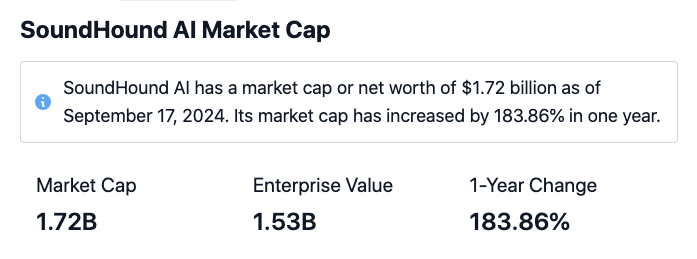Top 10 Ways To Evaluate The Cost And Pricing Of Ai Trading Platforms For Stocks
To get the most out of your investment, it is crucial to be aware of and compare pricing for AI software that predicts and analyzes stocks. Prices can be very different, so it's important to know the value you get for your money. Here are 10 top strategies to help you assess the cost and price of these platforms.
1. Learn about the pricing model
Subscription: Make sure to verify if a platform has a fee per year or month and what is included with each level.
Pay-per-use: Make sure the platform's charges are based on the use, for example, the number of trades (or request for data) or forecast.
Freemium: Determine the extent to which a platform provides a limited free tier and adds additional charges to access premium features.
2. Compare Pricing Tiers
Review the features of the various price levels, e.g. Basic, Professional, Enterprise.
Scalability: Make sure the pricing tiers you choose are in line to your requirements.
Upgrade flexibility: Find out if your plan can be easily upgraded or downgraded as your requirements change.
3. Evaluate Hidden Costs
Data fees - Verify whether the platform is charging an additional cost for access to the most valuable data (e.g. information in real-time, advanced analytics).
Brokerage charges - Check to find out if additional fees are charged by the platform for trade execution, or for integration with brokers.
API usage. Assess if extra charges are incurred for API access, or for frequent API use.
4. Demos and Trials are available for free
Trial period - Look for websites that offer the option of a trial or demo so you can check out the features before deciding to decide to sign up.
Trial limitations: Determine if the free trial includes all of the features, or if it is limited in its functionality.
Options with no commitment You are able to end your trial without incurring any charges if you find that the platform does not meet your requirements.
5. Find out about discounts and specials.
Annual discounts: See whether you qualify for an annual discount plan, compared to the monthly.
Referral Programs: Find out whether your platform offers discounts or credits for users who refer others to it.
Inquire about institutional or bulk pricing if your organization is large.
6. ROI (Return on Investment): How to evaluate the ROI?
Value and cost: Check the price of a platform with its features. Can it, for instance, help you to make better trade decisions or save time.
Track record of performance: Look at the platform's rate of success or user reviews to gain an understanding of the ROI potential.
Alternative costs: comparing the platform's price to the cost that might be incurred if it is not used (e.g. missed opportunities, manual analysis of data time).
Review Cancellation Policy Revision
Terms of cancellation: Make sure that you're able to end your contract without having to pay any hidden fees or penalties.
Refund policy: Find out whether the platform allows refunds on unused parts of your subscription.
Auto-renewal. Find out if the platform automatically renews your account. If so, you'll need to know how to optout.
8. Examine Pricing Transparency
A clear pricing page Ensure whether the platform has pricing pages that are precise, clear and does not contain any hidden fees.
Customer support: Contact customer support to discuss any pricing or cost issues.
Contract Terms: Review the conditions of service for any penalties or long-term agreements.
9. Check out your competition
Comparing the features and prices of different platforms against their rivals can help you find the most value.
User reviews: Research reviews from users to determine whether other users think the platform is worth the cost.
Market positioning: Determine whether it is priced as an expensive, mid-tier or a budget choice and if it is in line with your expectations.
10. Estimate the Long-Term cost
Price increases: Determine if there is a pattern of price rises and how often they occur.
Feature Additions: Evaluate if there are new features available in your current software or if you should upgrade.
Costs for scaling: Ensure that the platform pricing is reasonable in the event that you need to increase the volume of data or trading you require.
Bonus Tips
Try out multiple platforms. Try them all out with a no-cost trial to see how they perform.
Price negotiation: If you are an institution is frequent user, you should consider seeking out discounts or custom pricing.
There are numerous platforms that provide educational resources and tools for no cost.
The following tips can help you evaluate the pricing and costs of AI stock-predicting/analyzing trading platforms. It is possible to choose one that suits your budget and provides the features you need. A platform that is priced correctly will strike the right balance between affordability, functionality and performance in order to optimize the value of your trading. Check out the most popular coincheckup for more recommendations including copyright ai trading bot, stock market software, ai trading platform, ai trading bot, ai copyright trading bot, trade ai, free ai tool for stock market india, ai for stock trading, ai stock picks, chatgpt copyright and more.

Top 10 Ways To Evaluate The Regulatory Compliant Of Ai Stock Analysis And Prediction Platform
Compliance with regulatory requirements plays an essential aspect in evaluating AI platforms for stock prediction and analysis. Compliance assures that the system works within legal frameworks, protects the privacy of users, and conforms to the financial laws, reducing the chance of legal issues or financial sanctions. Here are top 10 tips for evaluating the conformity of these platforms.
1. Verify Registration and License
Regulators: Check that the platform has been registered and licensed with relevant financial regulatory authorities (e.g. SEC in U.S.A., FCA UK, ASIC Australia).
Verify partnerships with brokers. If the platform is integrated with brokers, be sure that they are properly licensed and regulated.
Public Records: Go to the website of your regulator agency for details on registration status or past violations, as well as other relevant data.
2. Look for data privacy Compliance
GDPR: Make sure that your platform adheres to the General Data Protection Regulation.
CCPA: California Consumer Privacy Act compliance is mandatory for users.
Policies for handling data. Examine the platform's privacy policies and ensure that it clarifies the ways in which data regarding users is collected, shared and kept.
3. Evaluation of Anti-Money Laundering/AML Measures
AML policies: Ensure that the platform is equipped with robust AML policy to identify and stop any laundering of money.
KYC procedures: Determine whether the platform is following Know Your Customer (KYC) methods to confirm the identities of users.
Monitoring transactions: Find out if the platform is able of monitoring transactions and reporting any suspicious activities to the relevant authorities.
4. Make sure you are in the compliance of Trading Regulations
Market manipulation: Make sure the platform has measures to prevent market manipulation, like spoofing or wash trading.
Order types: Ensure that the platform adheres to regulations regarding order types.
The best execution: Ensure that your platform is following the most efficient execution methods. This ensures that trades are carried out at the best possible price.
5. Assess the level of Cybersecurity Compliance
Data encryption: Ensure the platform has encryption in place to protect your personal information while it is in transit as well as in rest.
Response to incidents. Verify that there is a clearly defined incident response plan on the platform for cyberattacks as well as data breaches.
Certifications: Find out if a platform has been certified for cybersecurity (e.g. ISO 27001, SOC 2)
6. Transparency as well as Disclosure and Evaluation
Fee disclosure: Make sure the platform is transparent about all fees, including any hidden or additional fees.
Risk disclosure: Check if the platform includes clear information about risk. Especially for high-risk and leveraged trading strategies.
Performance reporting: Find out if the AI platform's models are clear and accurately recorded.
7. Make sure you're in compliance with International Regulations
Trans-border trade: If you trade internationally, ensure your platform is compliant with the rules in all the jurisdictions relevant to you.
Tax reporting: See if the platform offers tools or reports to assist users adhere to tax regulations.
Sanctions compliance - Make sure that the platform adheres to international sanctions and does not allow trading only with the countries or entities that are banned.
8. Reviewing Audit trail trails and Record-Keeping
Transaction records: Ensure that the platform maintains complete records for purposes of regulation and for audit.
User activity logs (logs) You can check to check if the platform records user activity such as transactions and logins. Also, verify if the account settings have changed.
Audit readiness: Make sure that the platform can provide all necessary documentation and logs if an audit by a regulatory agency occurs.
9. Assess Compliance with AI-specific Regulations
Algorithmic rules of trading: If the platform allows algorithmic trading, it must comply with European regulations like MiFID II and U.S. Reg SCI.
Fairness and bias: Find out whether the platform reduces or monitors its AI models to ensure ethical and fair trading.
Explainability - Ensure that the platform can provide clear and concise explanations regarding AI-driven predictions, decision-making, etc. in accordance with certain regulations.
10. Review user feedback and review the regulatory history
Reviewer feedback: Go through user feedback and then compare it with the platform's compliance with the regulations.
Historical Record: Search for violations in the past of regulations, fines or penalties.
Third-party checks: Check that the platform is in compliance with the law by checking whether it is subject to regular audits by third parties.
Bonus Tips
Legal consultation: Consult an expert on the subject to check whether your platform is in compliance with the regulations.
Trial period. Use the free trial or demo of the platform to test its compliance features.
Customer support: Make sure the platform provides support for questions or issues that concern compliance.
Following these tips can help you evaluate the regulatory compliance of an AI stock-predicting/analyzing trading platform. You'll be able to pick a system that is compliant with legal frameworks while protecting your rights. Compliance not only reduces the risk of legal violations, but it also helps build confidence and trust in the services of the platform. View the most popular source about ai stock for blog advice including ai investment advisor, ai investment app, stock market software, using ai to trade stocks, stocks ai, best stock advisor, best ai etf, ai copyright trading bot, copyright financial advisor, stocks ai and more.

Comments on “20 Good Facts For Deciding On Ai Trading Sites”